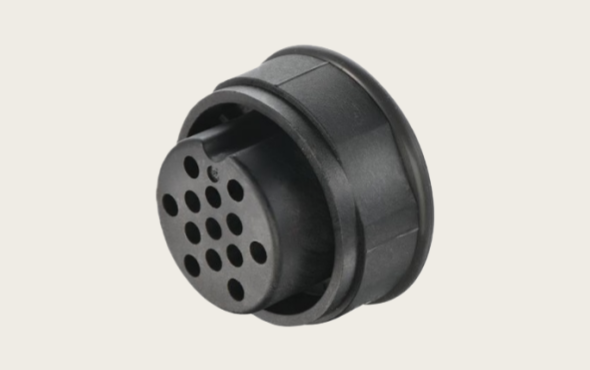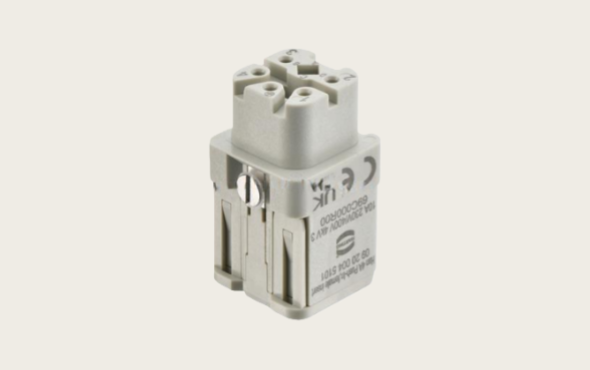When selecting connector types, in addition to size, pole number, brand, insertion and extraction cycles, and environmental adaptability, there is another key parameter: rated current (ampere). Especially in industrial equipment, new energy systems, rail transit, and high-power scenarios, this parameter directly determines system design, cable specifications, heat dissipation requirements, and safety margin. Today, let's take the German HARTING brand as an example and discuss its high current design, and extend the topic to "how many amperes can domestic connectors support."

HARTING high current connector design specifications
HARTING itself clearly states on its website that its Han® HPR series high current connectors support a rated current of up to approximately 1400 A.
●For example, the "Han® HPR HPTC" model, applicable for DC/AC high power connections, can reach 1400 A, with rated voltage up to 4800 V.
●In the slightly lower specification "Han® HPR VarioShell" module, it supports approximately 650 A × 6 poles.
Further down, in a general modular structure, such as the "Han K" series inserts, the rated current is about 100 A.
●Smaller-scale modules, such as the Han 70 A module, have a rated current of 70 A.
From these data, HARTING covers the current range from tens of amperes to thousands of amperes in connector design, providing solutions for systems of different scales and high power.

Then, how many amperes can the "domestic connector" support?
When comparing domestic connectors with international brands, the "current rating" is actually influenced by the following factors:
Contact material and structure: the larger the current, the thicker and more stable the contact copper alloy, coating, and pressing structure must be. HARTING's high current series uses large-section copper alloy and has strict mechanical structures.
●Heat dissipation and thermal stability: Under high current, a large amount of heat is generated, which requires considering the heat dissipation of the connector itself, heat conduction of the shell, and air flow. International brands have considered these factors in design.
● Contact life and reliability: High amperage ratings mean higher heat and mechanical load, so contact elastic force, locking mechanism, insertion and extraction times, and vibration resistance design must all match.
●Certification and Safety Standards: As listed by HARTING, its high current products meet rail traffic standards, vibration/shock standards, and voltage withstand standards.
● Domestic localization process: Many domestic connector manufacturers have launched "high current modular" products, but when it comes to the "thousands of amperes" level, there may still be a gap compared to international brands.
Therefore, from a practical perspective, it is completely feasible to use domestic connectors for general industrial equipment with currents ranging from tens to hundreds of amperes; however, if used for levels above 1000 A or in harsh environments, it is still recommended to refer to data from international brands or ensure that domestic alternatives meet the requirements in terms of structure, material, and certification.

3. Selection Suggestion: View the procurement plan from the perspective of "How many amperes supported"
●Define Current Requirements: Firstly, confirm the maximum current the connector needs to carry in your system, and consider future expansion, bypass, redundancy, etc.
●Check rated current and safety margin: For example, if the system requires 500 A, it is recommended to choose a connector with a rated current of 650-1000 A to leave a margin. HARTING's 650 A module is a reference.
●Focus on environmental conditions: whether it is high temperature, vibration, outdoor, wind power, rail transit, etc., the more stringent the environment, the higher the structural requirements for connectors. The HARTING high current series design is for such environments.
●Review the feasibility of domestic alternatives: When considering the replacement with domestic brands, it should be inquired in detail about their rated current, contact design, lifespan, certification status, and heat dissipation scheme.
●Budget and cost considerations: High current connectors are costly, large in size, and more complex to install; if domestically produced alternatives can meet the requirements under compatible conditions, it can significantly save costs.
●Supply and service support: Once a high current connector fails, the consequences are serious. When selecting, not only the product but also the supplier's service, spare parts support, and repair channels should be considered.

The question of how many amperes a domestic connector can support does not have a fixed numerical answer; it depends on the specific model, structure, material, and application environment. International brands like HARTING, for example, can support high current products up to hundreds or even thousands of amperes, providing us with a reference benchmark. For domestic connectors, many projects can handle tens to hundreds of amperes, but if applied in ultra-high power or stringent environmental conditions, it is necessary to carefully evaluate whether they meet international design standards.
In high current applications, selection cannot be based solely on "ampere rating." It is also necessary to consider the contact structure, heat dissipation, lifespan, environmental adaptability, and service system. Only through comprehensive evaluation can system stability and safe operation be guaranteed.
If you are interested in the domestic substitute products for HARTING brand connectors, or have procurement needs, or possess production or sales channels for such substitute products, and wish to engage in in-depth cooperation or communication, please contact us via the following contact information:
Manager Zhang (18665383950, WeChat number the same)Contact us, we look forward to working together with more industry partners.



